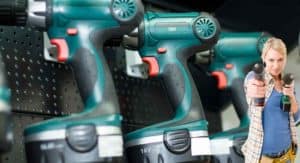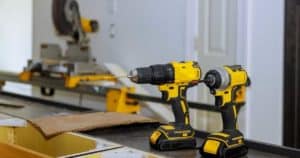
Are brushless tools more effective?
Are brushless tools more effective? The last few years have seen brushless motor technology dominate cordless power tools. The majority of major manufacturers now offer a
Multi-tools, also known as oscillating tools, are powerful tools that oscillate (rather than rotate and reciprocate), powered by mains or batteries.
Multi-tool is the name for the multiple functions this tool can perform using the variety of available attachments. The North American trade name “Master Tool” refers to the original Fein Multi-Master tool.
You can attach attachments for sawing and sanding as well as rasping, grinding, or scraping.
Fein, a German manufacturer, developed the original design of this oscillating tool. It was designed to remove plaster casts quickly and without cutting the patient.
Patented as a circular saw with an angle oscillating saw blade, this saw is now in use worldwide.
This original multi-tool saw was used in orthopedics to cut plaster casts. The oscillating rotation’s crescent shape cut through the cast without causing skin damage.
The plaster cast saw was the foundation of FEIN’s sophisticated oscillating power tools.

These tools are small and can be used in any orientation. It allows you to cut in places that would otherwise be difficult. Productivity increases by cutting complex or precise recesses without taking the workpiece out of its original position.
Even with end grain, it is possible to make precise and minor cuts. Furthermore, removing a small amount of wood from previous cuts, it is possible to ensure a perfect fit.
Attached to the tool is a mechanism that allows the accessory to rotate back and forth quickly, creating friction between the accessory and the workpiece. Because the oscillation angle is narrow, it will enable precise tool control. It does not kick like a reciprocating or rotating tool.
As these areas travel farther away from the center of your tool, the angle of oscillation causes more friction. This is especially evident with triangular sanding or grinding attachments, which enable the operator to reach corners and tight spaces.
Oscillating blades don’t clear the swarf as well as rotating blades. Therefore, moving the tool back and forth is vital to remove accumulated sawdust from the cutting area. The battery technology has improved to allow smaller and lighter devices than powered counterparts but still deliver the same performance without the limitations of cables.
Many attachments and blades on the market can be used with these machines. You can separate the blades into five main categories: cutting tile, grout & mortar, sanding and scraping, as well as polishing.
Standard saw cutting blades. They have different tooth configurations to suit other materials. These blades can be straight or have teeth at the end that allow the user to “plunge cut” into the material. Bi-metal blades are made with more minor, hardened teeth, allowing the user to cut soft metallics. The popular Japanese tooth blades have large, sharp teeth that can cut wood but not metal.
The grout, tile, and masonry attachments are either diamond-coated or carbide-coated. They allow you to clean grout between tiles and do light masonry work.
Standard sanding tools allow you to sand flat surfaces, while specialty attachments like the profile sanding tool allow more detailed work. In addition, the polishing pad attachments are growing in popularity and make it possible to polish.
Since multi-tools were first produced, the arbor attachment has changed widely. As a result, many machines use a unique arbor configuration. In addition, many after-market blade companies offer universal arbor attachments compatible with all oscillating multi-tool models.

Are brushless tools more effective? The last few years have seen brushless motor technology dominate cordless power tools. The majority of major manufacturers now offer a

Are aftermarket cordless tool batteries worth buying? Cordless tools can be used for many tasks and are easy to use. But, chargers and batteries can be

Best Cordless Tool Brands 2021 As the cord becomes a hassle, cordless power tools are growing in popularity. You have many options. Ryobi, Porter-Cable, and Black